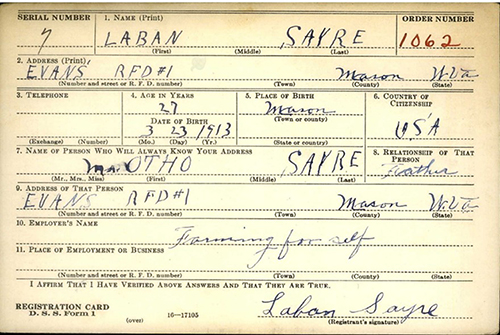

Remember...
Laban Sayre
1913-1943
"We know that enduring peace cannot be bought at the cost of other people's freedom."
President Franklin D. Roosevelt
 |
Remember...Laban Sayre
|
Laban Sayre was born on March 3, 1913, in Evans, Jackson County, West Virginia. While Evans in technically in Jackson County, Laban's story is most associated with the Union District of Mason County, Evans lying right on the county line. Thus, documents pertaining to Laban's life generally point to his living in Mason County. His parents were Otho ("Doc") Sayre and Susie L. Hill Sayre. Laban had two brothers: Richard and Ray. The family also included three sisters: Mead Jane Sayre, Georgia Sayre, and Hazel Sayre. (Family information is based on 1920, 1930, and 1940 Federal Census documents. Several family trees on Ancestry.com were consulted but are not cited here due to erroneous data points, e.g., citing Laban's death as occurring in Belgium.)
The 1940 Federal Census notes that Laban had completed elementary school (seventh grade) and worked 52 weeks in 1939. The 1930 census concurs, indicated that Laban was a farm laborer and classified his employment as "unpaid worker, member of the family." When Laban registered for the draft on October 16, 1941, he stated that he was "farming for self." Interestingly, his draft registration places Evans RFD #1 in Mason County. Less than six months later, Laban enlisted in the U.S. Army at Huntington, West Virginia.

Laban Sayre's draft card. Note that it shows his address to be Evans, but also locates it in Mason County. Courtesy of National Archives and Records Administration
Laban was assigned to the 325th Glider Infantry, 82nd Airborne Division. The unit history of the 325th is recounted on the website of the 82nd Airborne Division:
After the war [World War I], the colors of the 325th Regiment were cased but were to be unveiled once again on March 25, 1942 under the command of Colonel Claudius Easley. Located at Camp Claiborne, Louisiana, the Regiment was again to be part of the 82nd Division. Late in July 1943, the heavy equipment arrived that would turn the regiment into the 325th Motorized Infantry Regiment.This suddenly changed when the Chief of Staff, General Marshall had decided that the 82nd Division would be an excellent division to use as a base for his proposed Airborne force. General Omar Bradley, because of his excellent work in training the 82nd Division, was to be transferred to the 28th Division which was having a great deal of trouble in meeting its training objectives. General Matthew Ridgway, the 82nd Assistant Division Commander, would become its Commander.
The 325th Glider Infantry Regiment was formed and given the task of arriving into battle by glider. Parachutes could, and often did, wind up scattered for miles on a drop zone. The same held true for equipment and supplies. The glider was the answer to all these problems. As long as a glider stayed in one piece, the items inside it would too. This meant no more searching through the swamp looking for the missing barrel to a Howitzer. Jeeps could also fit into a glider. Best of all, troops could be put into a glider and land as a coherent fighting unit.
Gliderborne assaults, however, were not without their risks. Gliders and their tow planes were slow, fat targets. They had no armor to protect the men inside. Landing in a glider was also an adventure and little more than a controlled crash. Even if the pilot had the time and altitude to select a good spot to land, conditions on the ground of which he might be totally ignorant could wreck a landing. Ditches, wire, fences, tree stumps or a host of other possible ailments could flip, twist, or gut an unfortunate glider.
During the time of its introduction to the gliders, the Regiment lost its Commander. Colonel Easley was promoted to Brigadier General and went to the 96th Division. He was replaced by Colonel Harry Lewis who would guide the Regiment through its glider training and on to combat overseas. . . .
Salerno
The Regiment arrived to its first battle, not by air, but by sea. Boarding beach landing craft, the Regiment was sent to Salerno from the island of Sicily to reinforce American units already there. On September 15th [1943] at about 2300, they landed at Paestum, some eighteen miles south of Salerno where they awaited orders. Daybreak on the 16th brought orders. The 2nd Battalion was to re-board the landing craft and farther north to the town of Maiori. Here they were to be attached to Colonel William O. Darby's Ranger Task Force and relieve Ranger units currently holding positions on 4000 foot Mount St. Angelo di Cava. The Battalion was welcomed the next morning by a German artillery barrage. The Germans probed the Battalion lines. Despite numerous attempts to throw the Glidermen off the mountain, the Americans held their ground. It was here that the Regiment received its first casualties of the war. (The 82nd Airborne: World War II, "The 325th Glider Infantry Regiment," accessed 3 December 2024, https://ww2-airborne.us/units/325/325.html.)
Article prepared by Patricia Richards McClure
December 2024

West Virginia Archives and History welcomes any additional information that can be provided about these veterans, including photographs, family names, letters and other relevant personal history.